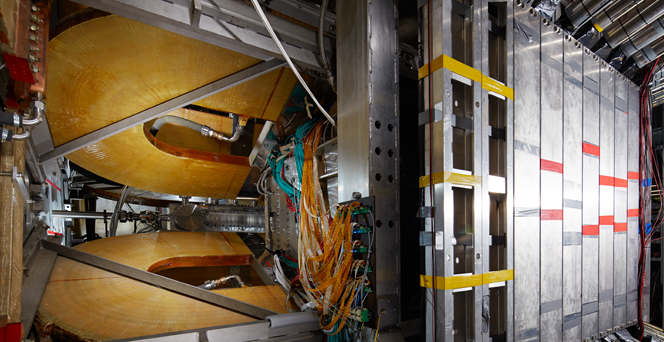URL: https://www.desy.de/e141261/e158573/e158812/index_eng.html
Breadcrumb Navigation

OLYMPUS
Particle physics experiment OLYMPUS
The DORIS accelerator at DESY was originally built for particle physics. Later, the storage ring served as a source of intense X-rays. The final experiment at DORIS marked a return to the facility’s roots: until early 2013, the OLYMPUS detector took data to find out new details about the behaviour of the proton.
An experiment at Jefferson Lab in the USA had discovered discrepancies in electron-proton collisions – the measurements differed from those obtained in previous experiments. One explanation for the deviations was that some collisions might involve the exchange of several photons rather than just one. OLYMPUS was designed to test this theory. In the "multi-photon" case, differences should arise when comparing the collisions of electrons and protons with those of positrons (anti-electrons) and protons.
Unique opportunities at DESY
To test this conjecture, the international team installed the OLYMPUS detector at DORIS. The detector itself was not new, but consisted mainly of the BLAST detector, which was operated from 2002 to 2005 at the BATES accelerator at the Massachusetts Institute of Technology (MIT) in the USA. The reason for the move to DESY was the unique conditions offered by the DORIS accelerator, which was one of the few facilities in the world that could be operated with both electrons and positrons. Moreover, it was possible to switch from one type of particle to the other within ten minutes.
The OLYMPUS scientists required both electrons and positrons for their measurements. The particles were shot at a hydrogen target located inside the detector. At MIT, the experiment could only be carried out with electrons. However, only with both types of particle can the researchers obtain evidence for so far undiscovered higher-order contributions. Switching between electrons and positrons at regular intervals also leads to more precise measurements.
Successful data taking
The OLYMPUS detector – a 50-tonne device nearly the size of a house – was shipped to Hamburg in 2010. Only a few adjustments had to be made to fit it into the DORIS ring. Data was then taken over a three-month period in 2012; the data acquisition ended with the shutdown of DORIS in January 2013. The scientists are now analysing the measurement data, hoping to obtain results with an uncertainty of less than one percent.


